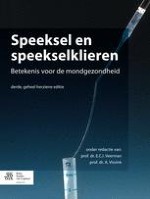2014 | OriginalPaper | Hoofdstuk
10. Speeksel en mondflora
Auteurs : A.J.M. Ligtenberg, E.C.I. Veerman, W. van ’t Hof
Gepubliceerd in: Speeksel en speekselklieren
Uitgeverij: Bohn Stafleu van Loghum
Samenvatting
-
De mondholte is een van de meest gekoloniseerde gebieden van het menselijk lichaam. 1 ml speeksel bevat 100 miljoen tot één miljard bacteriën. Er zijn minstens 600 vaste soorten aanwezig, daarnaast is er nog een grote individuele variatie.
-
Speekseleiwitten op het tandoppervlak en epitheel kunnen als receptor dienen voor bacteriën. In opgeloste toestand remmen dezelfde eiwitten de kolonisatie van het tandoppervlak door micro-organismen.
-
Speeksel is een belangrijke voedingsbron van orale bacteriën. Dit resulteert in een stabiel ecosysteem. Verstoring van dit ecosysteem, door frequente suikerconsumptie of antibioticumtherapie, resulteert in een schadelijker mondflora en verhoogde vatbaarheid voor mondinfecties.
